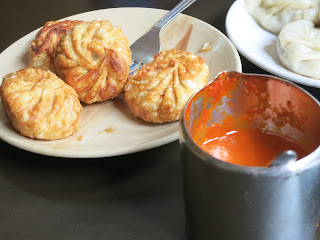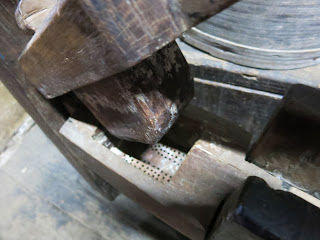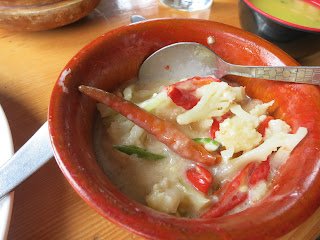On the way to Tiger's Nest, I found wild marijuana. It was at the side of a major street. Nonetheless, consuming marijuana is illegal in Bhutan.
The Tiger's Nest was more challenging than I expected. I was expecting somewhere around 5 hours for the round trip but it ended up being almost 7 hours. Not only did the altitude make it more difficult, but it was a national holiday so the trail was packed with both tourists and locals. But I'm not sure whether I could have walked faster even if it wasn't so crowded. It was a very steep climb. We started from 2220m and the Tiger's Nest is located at 3100m. So, I climbed up 880m. No wonder it was so tough.... Anyway, it was well worth it.
On the way back, we stopped by the cafeteria. My guess was right. The food was an Indian buffet. To make it worse, the flavor was very mediocre. My guide knows me well enough and got ema datsi from the kitchen just for me. This ema datsi was made with dried chili. It gives it a different flavor and texture. I did enjoy it as much as the version with fresh chili. The sauce was more watery but very flavorful.
I checked in at a very nice hotel by the Paro airport. Since this is the last night in Bhutan, the guide arranged a nice dinner at the hotel restaurant. The meal started with a corn soup. I'm sure the restaurant was trying to follow the western style.
Other dishes were served in a family style. Bitter melon. This is the second time to have bitter melon in Bhutan. It's a bit surprising because bitter melon is mostly consumed in sub tropical regions. But bitter melon originated in India. It probably came to Bhutan via India.
This is the first time I saw rice noodles in Bhutan. According to the guide, rice noodles are not very common in Bhutan despite the high consumption of rice. Very lightly seasoned.
On the first day, I had kewa datshi, which is potato and cheese. But this is a roasted potato. There is no sauce coating the potatoes. I didn't see/taste anything special so I'm guessing it's seasoned with just salt. However, it was very flavorful.
This is pork stew with so much pork fat. I'm not sure if pork belly or shoulder. But this is the first meat dish with so much fat because most meat dishes are made with dried meat. If not dried, it is usually the leaner cuts of meat.
Of course, every meal has to have ema datsi. Unfortunately, this is the last ema datsi in Bhutan because I'm leaving tomorrow morning. I strongly believe ema datsi is a very unique dish. There are no Bhutanese restaurants in where I live. There are a few Himalayan restaurant but I've never seen ema datsi. I really hope I can see ema datsi in the US soon.
Bhutanese cuisine is very unique because I don't see much relationship to the cuisine of other neighboring countries. Normally, there's more influence from surrounding countries but it seems Bhutan has established its own style. The most influential country for Bhutan should be India but I didn't see any dishes that resemble Indian curry. Not many spices are used in Bhutanese dishes. In fact, the only spice I saw in Bhutan was Szechuan pepper corn. Many dishes are as spicy as Indian foods but the way chili was used is completely different. Besides, I don't know other neighboring countries that use cheese in their dishes as much.
I did see quite a few Indian tourists. I strongly hope that Bhutanese can preserve their own culture for long time.







































